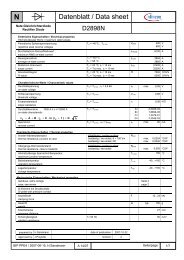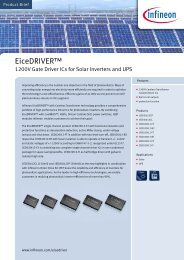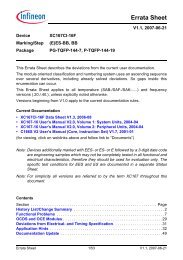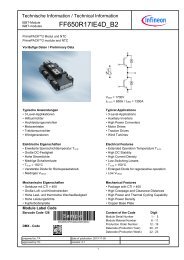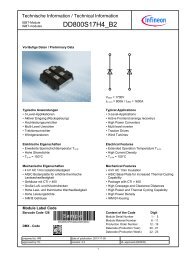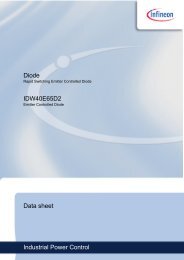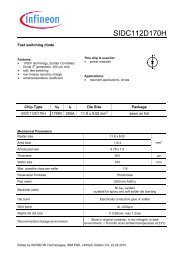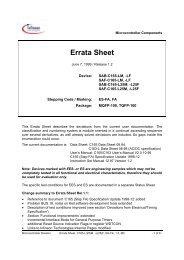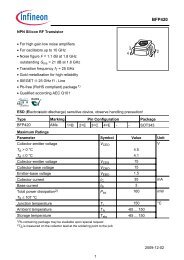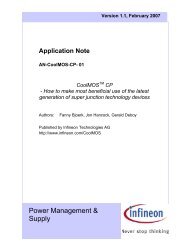C161PI AA / BA-H Step - Infineon
C161PI AA / BA-H Step - Infineon
C161PI AA / BA-H Step - Infineon
Create successful ePaper yourself
Turn your PDF publications into a flip-book with our unique Google optimized e-Paper software.
Note on Early (Unlatched) Chip Select Option<br />
As described in the User's Manuals (e.g. <strong>C161PI</strong> User's Manual, V1.0, 1999-08, p.9-11), an early<br />
(unlatched) address chip select signal (SYSCON.CSCFG = ‘1’) becomes active together with the<br />
address and BHE (if enabled) and remains active until the end of the current bus cycle. Early address<br />
chip select signals are not latched internally and may toggle intermediately while the address is<br />
changing.<br />
These effects may also occur on CSx# lines which are configured as RDCSx# and/or WRCSx# signals<br />
(BUSCONx.CSRENx = 1 and/or CSWENx = 1).<br />
The position of these transitions (spikes) is at the beginning of an external bus cycle or an internal<br />
XBUS cycle, indicated by the rising edge of signal ALE. The width of these transitions is ~ 5 ns<br />
(measured at a reference level of 2.0 V with Vdd = 5.0 V). The falling edge of the spike occurs in the<br />
same relation to RD#, WR#/WRH#/WRL# and to other CS# signals as if it was an address chip select<br />
signal with early chip select option.<br />
When CS# lines configured as RDCS# and/or WRCS# are used e.g. as output enable (OE#) signals<br />
for external devices or as clock input for shift registers, problems might occur (temporary bus<br />
contention during data float times (may be solved by tristate wait state), unexpected shift operations,<br />
etc.). When CS# lines configured as WRCS# are used as write enable (WE#) signals for external<br />
devices or FIFOs, internal locations may be overwritten with undefined data.<br />
When CS# lines are used as chip enable (CE#) signals for external memories, usually no problems are<br />
expected, since the falling edge of the spikes has the same characteristics as the falling edge of an<br />
access with a regular early (unlatched) address CS# signal. At this time, the memory control signals<br />
RD#, WR# (WRH#/WRL#) are on their inactive (high levels).<br />
Documentation Update<br />
(reference: <strong>C161PI</strong> User's Manual V1.0 1999-08)<br />
Structure of P3.0, P3.1<br />
Figure 7-13 on page 7-22 does not exactly represent the structure of P3.0 and P3.1 with respect to the<br />
alternate functions SCL0 and SDA0. These pins have the same structure as shown for Port 6 in Figure<br />
7-20 on page 7-32: the alternate output function and direction is controlled via the pin selection bits in<br />
register ICCFG.<br />
Microcontroller Division Errata Sheet, <strong>C161PI</strong>-L(25)M/F(3V), (ES-) <strong>AA</strong>, <strong>BA</strong>-H 1.6, es/Mh - 17 of 22 -



